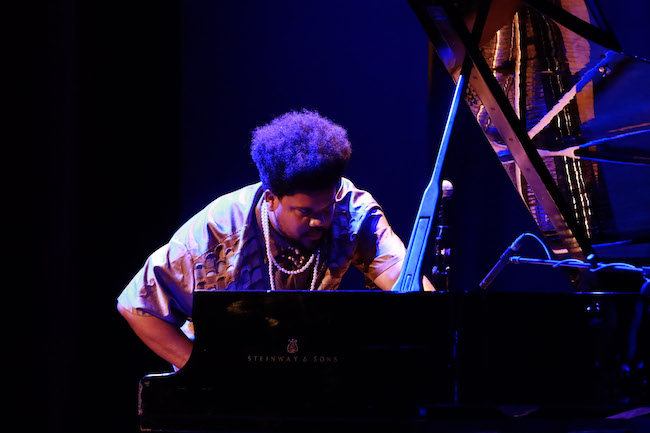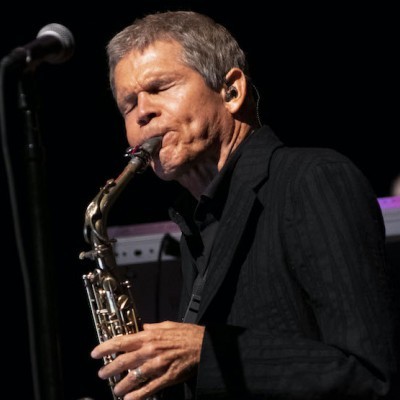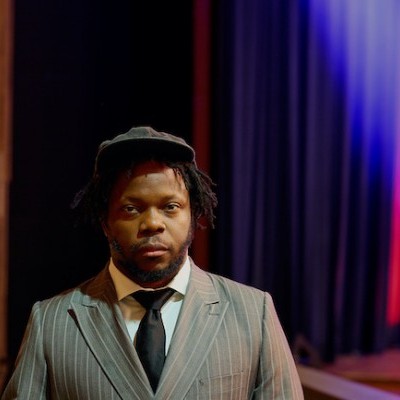Apr 2, 2024 12:59 PM
Saxophonist, Sonic Explorer Casey Benjamin Dies at 45
Casey Benjamin, the alto saxophonist, vocalist, keyboardist and producer who stamped his distinctive sounds on the…

“I want to inform myself to better convey ideas about nature and sustainability through my music,” says Freitas.
(Photo: Bruno Zanardo)Although Brazilian pianist Amaro Freitas amply displayed his compositional brilliance and instrumental derring-do on three trio albums between 2016 and 2021, his solo recital last March, one that opened the 2023 Bergamo Jazz Festival, proved to be mind-blowing.
Freitas performed originals from his third date, Sankofa (Far Out), and individualistic interpretations of Wayne Shorter’s “Footprints” and John Coltrane’s “Giant Steps.” His own pieces featured strong melodies narratively focused on Afro-Brazilian and indigenous dance and carnival traditions, upon which he improvised orchestrally with vocabulary culled from the jazz and Euro-classical canons and various folkloric dialects, tossing off complex polymetric passages, some at extreme velocities and deploying homegrown extended techniques.
As an example, on one piece, Freitas applied a shaker to different areas of the piano’s exoskeleton and strings, which he’d prepared in real time with Amazonian seeds, clothespins and other objects, eliciting the sound of a sampled drum ensemble. On another, he addressed a wood-encased mbira that stood to the right of the piano bench, executing a brisk melodic right-hand line that he answered contrapuntally on the piano.
He morphed the “Footprints” refrain into a dense harmonic forest, carving a pathway with clearly articulated, jackhammered lines that evoked a pointillistic Cecil Taylor. He revisited the piano-as-hand-drum trope on “Giant Steps,” caressing the melody with legato touch at a ballad tempo, gradually building to another Taylor-esque explosion, then decrescendoing to a crystalline theme restatement.
Four months later, Freitas and his breathe-as-one trio at the Amazonas played the Green Jazz Festival in Manaus, Brazil, a city of 2 million that lies adjacent to the dense Amazon forest at the conjunction of the Rivers Negro and Solimões that coalesce into the Amazon River, 2,870 miles west of his hometown, Recife, a city of 1.6 million on Brazil’s Atlantic coast. After 50 minutes, he dismissed his bandmates, concluding the concert with a long, ritualistic solo piece.
In a post-concert interview (translated by Brazilian composer-saxophonist Felipe Salles), the 31-year-old pianist explained the new album’s title, which references an Adinkra symbol depicting a backwards-facing bird in flight, a pungent metaphor for the notion of “going back to our roots to realize our potential to move forward.” He first saw the image at an African market in Harlem back in 2019, while in the city for a trio gig at Dizzy’s Club. It sparked within Freitas a consciousness that the music he’d grown up listening to in his father’s evangelical church, where “a lot of African traditions had been erased or denied,” had a direct connection to African antecedents.
It was well after midnight, but Freitas — who’d spent most of the afternoon in the jungle with a local ecologist — showed no signs of fatigue. He mentioned that the solo vignette foreshadowed his latest release, Y’Y (Psychic Hotline) (with Hamid Drake, Shabaka Hutchings, Jeff Parker and Brandee Younger as collaborators), inspired by a visit to Manaus in 2020 that connected him to the rituals, customs and spirits of the regional Sateré Mawé indigenous community.
“I want to inform myself to better convey ideas about nature and sustainability through my music,” Freitas said. “Our culture in Brazil doesn’t support the memory of the nation’s pre-colonial culture. I want to be an artist who shows how potent this culture and heritage is and how it can connect with the world.”
As Freitas spoke about his formative years, it was apparent that, from the beginning, he’s extrapolated quotidian experience into notes and tones in a similarly immersive manner. Now 31, he began on piano at 11, when his father assigned him to switch from drums to play at church services. At 15, he entered the local conservatory. Strained finances forced him to drop out six months later, but he practiced assiduously on a keyboard, learning autodidactically via “different circles of people in Recife who brought me information on harmony, polyrhythms and so on.” That year, after hearing a Chick Corea concert DVD, Freitas essayed his first efforts at composition.
“I was inspired by the depth of his concept, which has improvisation but also contains a long form that the musicians must learn deeply in order to connect — on the level of Jobim,” he said. Over the ensuing years, his sense of improvisational possibility expanded as he absorbed albums by Keith Jarrett, Gonzalo Rubalcaba, Herbie Hancock, Michel Petrucciani and Oscar Peterson.
Freitas worked odd jobs for several years to finance his musical studies. Eventually, he landed a long sinecure playing standards at Recife’s Mingus Jazz Bar, while devoting off-hours to the compound-meter compositions that appear on his first album, the self-financed Sangue Negro. He spent quality time absorbing the rhythmic and textural worlds of Cecil Taylor and Thelonious Monk, practicing “six to eight hours a day, five days a week,” he said. His trio wasn’t keeping up, and his desire to refract his explorations into artistic practice prompted him to focus on the solo space and piano preparation.
He opines that these ministrations positioned him to connect to the energies exhibited by similarly ancient-to-future-oriented creative musicians like Hutchings, Drake, Parker and Younger, as Wayne Shorter did with Milton Nascimento on Native Dancer, or Pixinguinha with American jazz musicians in Paris a century ago. Freitas also admires such like-minded Brazilian elders as Moacir Santos (for “working out the candomble rhythms of the orishas in the structure of orchestration”), Hermeto Pascoal, Dom Salvador and Egberto Gismonti.
“It’s important to me that the Brazilian artist is the protagonist of this work, and not the supporting actor, like Nascimento was on Native Dancer,” Freitas said of Y’Y. For now, even as his international profile expands, he intends to remain based in Recife.
“I made an important point by breaking the myth that every successful musician either goes to São Paulo or to New York. For those who live in Recife, it brings forth a whole other possibility, a sense of worth.” DB

Benjamin possessed a fluid, round sound on the alto saxophone, and he was often most recognizable by the layers of electronic effects that he put onto the instrument.
Apr 2, 2024 12:59 PM
Casey Benjamin, the alto saxophonist, vocalist, keyboardist and producer who stamped his distinctive sounds on the…

Albert “Tootie” Heath (1935–2024) followed in the tradition of drummer Kenny Clarke, his idol.
Apr 5, 2024 10:28 AM
Albert “Tootie” Heath, a drummer of impeccable taste and time who was the youngest of three jazz-legend brothers…

Sanborn’s highly stylized playing and searing signature sound — frequently ornamented with thrill-inducing split-tones and bluesy bent notes — influenced generations of jazz and blues saxophonists.
May 14, 2024 3:13 PM
David Sanborn, the star alto saxophonist who masterfully straddled the realms of straightahead jazz, R&B, rock and…

Henry Threadgill performs with Zooid at Big Ears in Knoxville, Tennessee.
Apr 9, 2024 11:30 AM
Big Ears, the annual four-day music celebration that first took place in 2009 in Knoxville, Tennessee, could well be…

“I’m also at a point in my life where I don’t feel like I have anything to prove, like at all,” Akinmusire says about his art.
Mar 26, 2024 12:45 PM
At the risk of oversimplifying and romanticizing the story, Ambrose Akinmusire came bursting on the jazz scene at the…